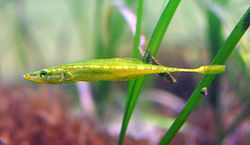| Spinachia | |
|---|---|
 | |
| Sea Stickleback (Spinachia spinachia) | |
| Scientific classification | |
| Kingdom: | Animalia |
| Phylum: | Chordata |
| Class: | Actinopterygii |
| Order: | Perciformes |
| Family: | Gasterosteidae |
| Genus: | Spinachia G. Cuvier, 1816 |
| Species: | S. spinachia |
| Binomial name | |
| Spinachia spinachia | |
| Synonyms [2] | |
Spinachia is a monospecific genus of ray-finned fish belonging to the family Gasterosteidae, the sticklebacks. The only species in the genus is Spinachia spinachia, the sea stickleback, fifteen-spined stickleback or fifteenspine stickleback, a species which lives in benthopelagic and in brackish environments of the northeastern Atlantic Ocean. This species, the largest of the sticklebacks, grows to a length of 22 centimetres (8.7 in) SL. This species is the only known member of its genus Spinachia. It is of no interest as a commercial fish.
